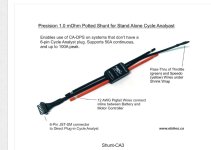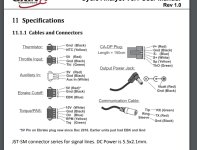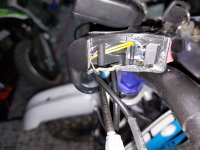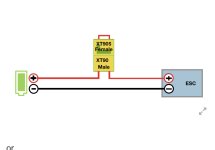DanGT86 said:Since you are OK with the total amount of power but just want to tame the throttle ramp I would suggest removing all the power limits thru the CA3 and setting the throttle in Pass-thru mode. This will eliminate some of the more tricky gain settings that come into play when you are actually trying to limit power. I think you will be fine just using the throttle ramp/time settings to do the taming.
I would start like this:
Begin with the throttle input and output voltage minimums. Start with the wheel in the air and the CA throttle set to bypass. Your controller is looking for about 1v closed throttle and around 4v full throttle. There is a throttle input/output display screen on the CA3 that will show you the throttle signal in vs what its sending out. You can use this screen to figure out at what voltage the controller starts to turn the motor. You will set your minimum throttle out just below this point. You also can use this screen to figure out the minimum signal your throttle is sending out when its closed. You can set the minimum throttle in just slightly above this point and it will eliminate the dead spot at the bottom. Even without the throttle output of the CA3 going to your controller you can use this throttle screen to make sure everything is set as responsive as possible. Its pretty clever. Basically you are looking for the CA to not be sending any signal out when the throttle is closed but you dont want the first 10% of throttle twist being ignored either. Once you get that set set the CA in pass through and move on to the throttle output ramp rate settings.
Try a throttle ramp up of 0.3 - 0.5 volts per second to start and increase from there. When you get up around 5-6v per second it becomes almost imperceptible to human brains and will probably feel exactly like the controller did without the CA. Do this testing with smooth continuous accelerations. Once you get the acceleration how you want then move on to the fast throttle up settings.
Start with the Fast throttle up rate to 1-2V/sec. The fast throttle up eliminates the dead band or slack in the throttle when the bike is rolling along at speed. It ramps the throttle up super fast until it feels a slight load then it reverts to your normal throttle ramp. It makes the bike feel way more responsive from a roll. Otherwise a bike rolling along at moderate speed will feel like there is a delay and then a hard kick. A motor free spinning with no load will consume about 1-2 amps. If you set the Fast throttle up current threshold at 2 amps then when you are rolling along at speed and you tip into the throttle it will will quickly ramp until it feels 2 amps and then it knows it has caught up. Once this is all set correctly the bike will feel very responsive but not any more violent than it does when accelerating constantly from a dead stop. If you set the fast up current threshold too high then it will kick for just a second and then smooth out to normal acceleration. The goal with this is to eliminate all of the slack/delay when throttling from a roll but not have it overshoot because its ramping up super fast. Its a bit of a balancing act.
If you got the programing cable and the CA3 parameter editor you can post screenshots of your settings and we can probably help a bit if you are having trouble. The instruction manual is really good too. I'll look around for one of my CA files from a 4kw chain drive motor I had. That might give you an idea of some starting points.
This was awesome!! The CA is supposed to arrive today so I'll give this a shot tonight if it arrives, sounds alot easier than I thought, I hope so anyway!
Sounds awesome if I can control the throttle respons
Now im coming with another question
https://www.superbilligt.se/cross-mc/cross-fiddy-offroad/el-1/2000w/el-cross-e-dirt-q-bike-xtreme-2000w-10957
This is in swedish but some part might be understandable, its a dirt bike 2000w 60V 20ah battery, said to have decent torque and a top speed of 70km/h with a 100kg driver and drives up to 80km..
Im able to buy this for 600usd, it looks worse than a diy bike in my eyes.. too much bling, headlights,blinkers and stuff even thought its illegal to drive it here, would just be something to drive next to my son.. it retail for 1400usd but might be worth 600usd?
What are you thought on it? Could 72v work with it without burning up the motor? Or keep it stock? Should I buy it as a placeholder until I do something for myself overtime?
Yay or nay? Opinions?
Best regards







